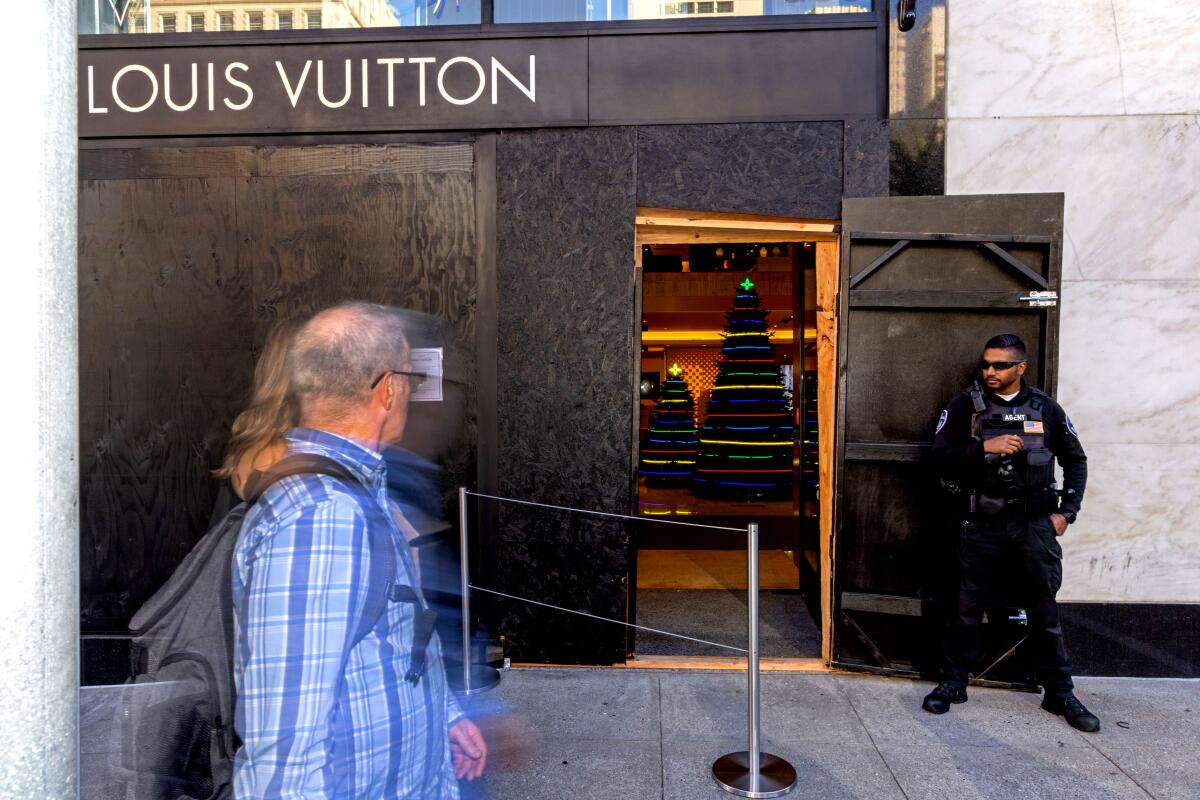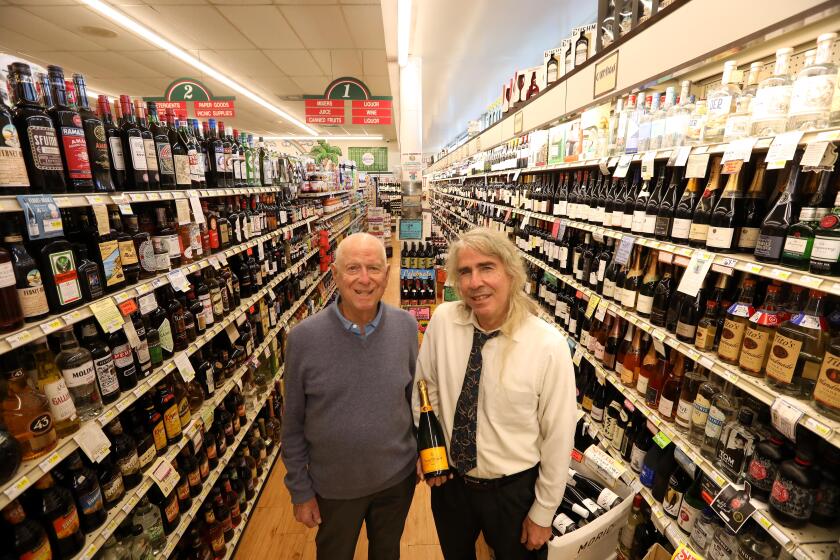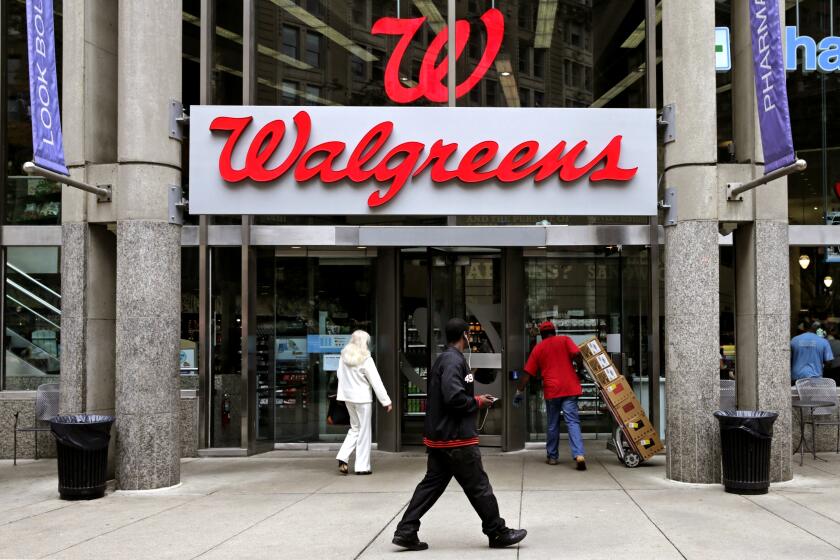Retailers say thefts are at crisis level. The numbers say otherwise

- Share via
Organized retail crime is haunting the nation this holiday season.
Captured on smartphones and closed-circuit cameras, thefts involving groups of people smashing windows or individuals wheeling loaded shopping carts past security guards and out the door have been looping on social media and TV news, raising the specter that crime rings reselling boosted merchandise present a major threat to retailers.
With industry groups sounding the alarm, politicians have declared the issue a priority. California Gov. Gavin Newsom said he would increase the budget of the California Highway Patrol next year to beef up its Organized Retail Theft task force. California Atty. Gen. Rob Bonta met with retailers, online marketplace companies and law enforcement Tuesday to develop strategies to fight organized retail crime. Police and prosecutors say criminal justice reforms need to be rolled back to deter smash-and-grabs.
Although some retail and law enforcement lobbyists cite eye-popping figures, there is reason to doubt the problem is anywhere near as large or widespread as they say. The best estimates available put losses at around 7 cents per $100 of sales on average.
It’s easy to get attention for sensational claims, however, particularly when they come from official sources. Rachel Michelin, president of the California Retailers Assn., told the San Jose Mercury News that in San Francisco and Oakland alone, businesses lose $3.6 billion to organized retail crime each year.
That would mean retail gangs steal nearly 25% of total sales in San Francisco and Oakland combined, which amounted to around $15.5 billion in 2019, according to the state agency that tracks sales tax.
Can that be right? In a word: no.
The country’s largest retail industry group, the National Retail Federation, estimated in its latest report that losses from organized retail theft average $700,000 per $1 billion in sales — or 0.07% of total sales — an amount roughly 330 times lower than the CRA’s estimate.
Asked how the organization arrived at that figure, a CRA staffer said that “there’s no way of knowing exactly” how much organized retail crime affects the bottom line of businesses. The staffer said the estimate was based on a back-of-the-napkin calculation: If organized retail thieves steal $70 billion annually, and California accounts for 10% of the U.S., California’s losses add up to $7 billion, meaning the Bay Area “is likely in the billions itself.”
Prices for wine, beer and spirits are up compared with a year ago because of supply chain problems, material shortages and higher costs. Expect it to get worse.
Leaving aside some of those assumptions, how did they come up with that $70-billion number? The staffer pointed to a report from the Retail Industry Leaders Assn. published this year. But that report didn’t find that organized retail thieves stole $68.9 billion per year at all — it estimated that all retail crime combined, including employee theft, regular shoplifting and fraud, added up to that number.
An industry advocate made a similar error in front of the Senate Judiciary Committee in early November. At a hearing on regulating online marketplaces, Ben Dugan, president of the National Coalition of Law Enforcement and Retail, or CLEAR, and director of organized retail crime response at CVS Health, told the committee that “CLEAR estimates that organized retail crime accounts for $45 billion in annual losses for retailers.”
When asked where that number came from, Rich Rossman, vice president of CLEAR and sergeant with the Broward County (Fla.) Sheriff’s Office, said that it was pulled from the National Retail Federation’s report. But the NRF puts all losses to theft and fraud from all sources at around $45 billion, not losses to organized retail crime.
The $25-billion discrepancy between the figures touted by the two industry groups suggests the difficulty of quantifying any problem in an industry as splintered as retail. When it comes to organized retail crime specifically, the best estimates appear much smaller.
With the 55 member companies that responded to its latest annual survey representing about 25% of all U.S. retail sales, the National Retail Federation has the clearest window into broader trends, said Mark Mathews, who leads the NRF’s research team.
Its latest report found that total “shrink” — the industry term for all inventory losses from theft and fraud, internal and external, as well as paperwork errors — grew from 1.4% to 1.6% of sales on average from 2015 to 2020. The estimated portion of those losses coming from organized retail crime grew from 0.045% to 0.07% in the same timeframe.
With $3.1 trillion in bricks-and-mortar retail sales in 2020, that puts estimates for total shrink at $49.6 billion and losses to organized retail crime at $2.1 billion nationwide.
Although the NRF publishes its organized retail crime estimates each year, the group stopped publishing a detailed breakdown of the sources of shrink in 2019. But in 2018 its survey found that 35.7% of shrink came from shoplifting or organized retail crime, and 33.2% came from employee theft. Both percentages had declined since 2015, and a different sort of risk — paperwork error — hit 18.8% of total shrink in 2018.
Mathews said some categories of retailers face higher rates of organized retail theft, with those that sell easily portable and salable goods at higher risk. In his Senate testimony, Dugan reported that CVS Health loses more than $200 million a year to organized retail crime, or 0.21% of its $91 billion in 2020 retail revenue, a rate three times higher than the national average.
For the record:
1:37 p.m. Dec. 15, 2021An earlier version of this article incorrectly said the National Retail Federation had taken no public position on the INFORM Consumers Act. The group has endorsed a recent version of the bill with limited reporting requirements for sellers.
The Retail Industry Leaders Assn. released its own report, which put that nearly $70-billion price tag on total retail crime, in late November as part of its campaign with a spin-off group, the Buy Safe America Coalition, to lobby for a federal bill that would make it more difficult for people to anonymously sell goods on internet marketplaces. An earlier version of that bill, the INFORM Consumers Act, would have required online marketplaces such as EBay, Etsy and Amazon to verify the identity of sellers who make hundreds of sales or bring in more than $5,000 a year with their accounts. The National Retail Federation, which counts Amazon among its members, has endorsed a more recent version of the bill that has more limited reporting requirements for sellers.
Walgreens says it is closing 5 more San Francisco stores over retail theft. However, city leaders are not too convinced that’s the reason.
Mathews at the NRF found fault with the methodology behind RILA’s report, which was based on data from five retail companies and written by John Dunham & Associates, a consulting firm that produces reports for corporations and industry groups (and whose founder was an in-house economist at Philip Morris in the 1990s). “I wouldn’t feel comfortable in putting out data with that few respondents, frankly,” Mathews said.
Jason Brewer, head of communications and marketing at RILA, said that he could not provide more details on the data in the group’s study because members had submitted it confidentially, and he could not say what percentage of total sales they represent. But he did defend its significance, saying that the respondents “represent a cross section of retail, which included grocery, home improvement, pharmacy, general merchandise and clothing,” and that “based on the conversations we’ve had with asset protection professionals, these numbers are probably conservative.”
Even if the dueling retail associations can’t agree on their numbers, they agree on the principle that organized retail crime is better dealt with away from stores and at the level of the fences — the people reselling the stolen goods.
Broader crime statistics paint a picture of a decreasing problem, not one on the rise. National crime statistics from the FBI show shoplifting decreasing steadily every year from 2015 through 2020, the most recent data available. Larceny — the taking of property without using force or breaking in — declined 16% between 2010 and 2019, then dipped even lower in 2020, the data indicate.
At a local level, more up-to-date statistics sharpen the image of a waning problem. Property crime in Los Angeles is up 2.6% from last year, according to LAPD numbers published Nov. 27, but down 6.6% from 2019. The category that includes shoplifting — “personal/other theft” per LAPD — is down 32% from 2019. A San Francisco Chronicle analysis of that city’s shoplifting crime data showed that the number of monthly reports had changed little in the last three years, though it also raised some major questions about the accuracy of shoplifting reporting to law enforcement. Smash-and-grab thefts are classified differently because they involve violence, trespassing and high-value hauls, and suspects have been charged with robbery, burglary or grand theft after recent incidents in L.A. and San Francisco.
One thing that has gone up is the visibility of open theft from stores. Ubiquitous security cameras and smartphones mean that few crimes go unrecorded, and videos of people loading up bags and carts with products and walking out the door make for viral content.
The ease of committing a crime like that is, in some part, traceable to decisions made by the retailers themselves, according to industry analysts.
Tony Sheppard, an executive at Canadian loss prevention software company ThinkLP, received his first exposure to the issue as a store detective at a Montgomery Ward store in the Boston area in the 1990s. “The first shoplifter I ever went to detain was a booster stealing a whole rack of coats,” Sheppard said. At the time, he carried handcuffs and detained the suspected thief himself. “Nowadays, unfortunately, because of safety concerns and liability issues, a lot of companies are very hands-off.”
Lawsuits from people injured by security guards in the process of apprehending shoplifters — in some cases, even from the alleged shoplifters themselves — have made aggressive in-store policing a losing proposition, Sheppard said.
In one recent case, a West Virginia woman won nearly $17 million in damages from Walmart after she was injured when a man being pursued for shoplifting stumbled into her, on the basis that Walmart escalated the situation. “Most companies realized from a financial standpoint it’s just not worth it. A couple big lawsuits take away anything you gain by making all those apprehensions,” he said.
Sometimes hiring staff to stop shoplifters in the first place doesn’t make financial sense, security consultant Chris McGoey said. “To hire and train a loss prevention department, especially a competent one, costs money,” McGoey said. Some retailers have found that the cost of the merchandise recovered by security staff was lower than the cost of employing them. “It’s almost cheaper to do nothing and just take the loss” on that basis, McGoey said, “but then you pile liability on top, it’s a no-brainer.”
The spectacular nature of the recent smash-and-grab robberies might change that calculus for retailers, McGoey said, and lead to beefed-up security staffing and putting more products behind lock and key. But he doubts it.
“Modern merchandising is about getting your merchandise up in front. You want it highly visible,” McGoey said. “We’ve gone through cycles where you put high-theft items in locked cases, but that’s anti-merchandising, that’s anti-retail management. The merchants hate it.”
For small businesses that lack the record profit margins of national chains, hiring additional staff to deter theft or putting items behind plexiglass may not be options, and a theft that involves a smashed window, even if covered by insurance, can impose a heavy toll in lost time and sales.
On the other hand, stolen merchandise can sometimes be recovered. The CHP reported that it contributed to recovering $20 million in merchandise stolen by organized theft rings in 2020. If the national average of 0.07% losses holds for California — Mathews at the NRF said the group could not break out data by state — that’s more than 10% of losses to organized retail theft in the state, well above the national recovery rate for stolen items (excluding cars), which hovers below 4%, according to the FBI.
More to Read
Start your day right
Sign up for Essential California for the L.A. Times biggest news, features and recommendations in your inbox six days a week.
You may occasionally receive promotional content from the Los Angeles Times.













